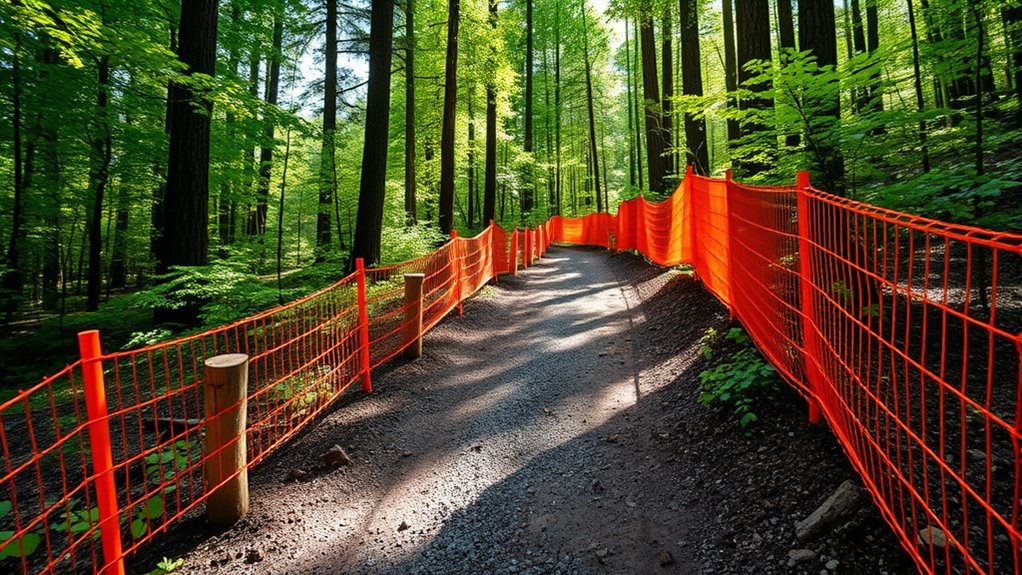To control erosion on woods roads and trails, you should focus on managing water runoff by installing structures like water bars, drainage dips, and culverts to divert water away from vulnerable areas. Reinforce trail surfaces with gravel or crushed stone, and keep vegetation along edges healthy to stabilize soil. Regularly maintain drainage features and clear debris to prevent blockages. Continuing along this path will reveal more effective strategies to protect your trails and landscape.
Key Takeaways
- Install drainage dips, culverts, and water bars to divert water away from trail surfaces and prevent erosion.
- Use gravel, crushed stone, and geotextile fabric to reinforce trail surfaces and stabilize soil.
- Maintain vegetation along trail edges to absorb excess water and reduce runoff velocity.
- Regularly clear debris from drainage features and repair damaged structures after storms.
- Conduct routine inspections and adjust erosion control measures based on natural water flow and trail conditions.

Erosion on woods roads and trails can quickly degrade the landscape and make travel difficult. When water runoff isn’t managed properly, it washes away soil, creates ruts, and damages the trail surface. To prevent this, implementing effective water diversion techniques is vital. Water diversion involves redirecting runoff away from vulnerable areas, often through the use of drainage dips, culverts, or swales. These structures guide water off the trail, reducing the erosive force and preserving the trail’s integrity. Proper placement of these features ensures that water flows away from critical sections, preventing the formation of deep ruts and gullies that can compromise safety and access.
Effective water diversion protects trails from erosion and maintains safe, sustainable access.
Trail stabilization is equally important in controlling erosion. It involves reinforcing the trail surface so it withstands water flow and foot or vehicle traffic. Installing gravel or crushed stone on the trail helps create a stable, permeable surface that reduces water pooling and limits erosion. In some cases, adding geotextile fabric beneath the gravel prevents mixing with underlying soil, further strengthening the trail. Vegetation plays an essential role in trail stabilization as well. Planting native grasses, shrubs, or ground cover along the edges of the trail helps anchor the soil, absorb excess water, and reduce runoff velocity. Maintaining vegetation cover is a simple yet effective way to keep erosion at bay.
You should also consider creating water bars or drainage dips at regular intervals along the trail. These small, shallow depressions collect water and direct it across the trail, preventing it from running straight down the slope and causing erosion. Regular maintenance of these features ensures they remain functional and effective. When designing or repairing woods roads and trails, always evaluate the natural flow of water and adjust your water diversion strategies accordingly. Avoid placing drainage structures in areas prone to heavy water flow or where they could cause unintended damage.
Additionally, using vacuums for dirt removal can assist in clearing debris that might block drainage features or cause water to pool, further reducing erosion risks. Finally, consistent monitoring and maintenance are key to long-term erosion control. After heavy rains or storms, check for signs of erosion, damaged drainage features, or new ruts. Promptly repair and reseed disturbed areas to restore vegetation and prevent further erosion. By combining water diversion techniques with trail stabilization efforts, you can greatly extend the life of your woods roads and trails, ensuring they remain safe and accessible for everyone. Proper erosion control not only preserves the landscape but also reduces maintenance costs and environmental impact over time.
Frequently Asked Questions
How Often Should Erosion Control Measures Be Inspected?
You should inspect erosion control measures at least quarterly and after significant weather events, like heavy rains or storms. Regular inspection helps identify issues early, so you can schedule maintenance promptly. Keep a detailed log of inspection dates and findings to plan your maintenance scheduling effectively. By staying proactive, you guarantee your erosion control measures remain effective, protecting the environment and extending the lifespan of your woods roads and trails.
What Materials Are Most Effective for Erosion Barriers?
You should use biodegradable barriers like coir logs or straw wattles combined with native plantings, which are highly effective for erosion control. These materials decompose naturally, reducing environmental impact while stabilizing soil. Native plantings encourage root growth, further anchoring the soil. Together, biodegradable barriers and native vegetation create a sustainable, long-lasting solution that minimizes erosion and promotes healthy ecosystem recovery on woods roads and trails.
Can Erosion Control Methods Be Applied During Rainy Seasons?
Yes, you can apply erosion control methods during rainy season challenges, but timing is vital. You need to assess weather forecasts, avoid applying materials during heavy rains, and prioritize quick-acting solutions. Proper planning and proactive measures help you prevent runoff, stabilize soil, and protect your trails effectively. By focusing on erosion control timing, you guarantee your efforts are successful, even in wet conditions, safeguarding the landscape and maintaining trail integrity.
Are There Specific Regulations for Erosion Control on Public Lands?
Yes, there are specific regulations for erosion control on public lands. You need to follow guidelines for trail maintenance and sediment management to prevent environmental damage. These rules often require permits and adherence to best practices, especially during active trail use or construction. You should consult local agencies or land management authorities to verify compliance and implement effective erosion control measures that protect natural resources and promote sustainable trails.
How Do You Prioritize Erosion Control Projects on Multiple Trails?
You should prioritize erosion control projects by evaluating trail conditions, focusing on those with the most significant erosion issues. Incorporate trail maintenance and vegetation management to stabilize slopes and prevent further damage. Address high-traffic or vulnerable areas first, and consider environmental impact. Regular inspections help identify emerging problems, ensuring you allocate resources effectively. This proactive approach keeps trails sustainable, safe, and minimizes long-term erosion.
Conclusion
By implementing proper erosion control methods, you can protect your woods roads and trails from the relentless forces of nature. Remember, each action you take is a brick in the fortress against erosion’s march. Don’t let runoff wash away your efforts—stand firm like a mighty oak. With vigilance and care, you make certain these paths remain resilient and beautiful for generations to come. After all, isn’t it worth fighting to preserve the natural beauty around you?









